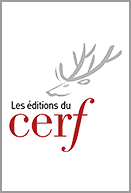Du Christ à la Trinité - CF 283
de Étienne Vetö
Collection Cogitatio Fidei - N° 283
480 pages - mars 2012
49,50€
Le lieu premier de manifestation de la Trinité est la figure du Christ en ses mystères. La foi trinitaire ne résulte pas d'une subtile articulation entre unité et pluralité, mais d'une méditation sur le rapport de Jésus à son Père et à leur Esprit commun. Telle est la première thèse du présent ouvrage, qui sera vérifiée par l'exploration de la portée trinitaire des mystères du Christ chez deux grands maîtres : pour Thomas d'Aquin, la Trinité est la clé d'interprétation et l'horizon de compréhension de la « vita Christi » ; pour Hans Urs von Balthasar, la figure du Christ et ses mystères sont le lieu par excellence de la révélation de la triunité de Dieu. Un nœud redoutable se présente toutefois : lorsque le Père, le Fils et l'Esprit agissent dans l'économie, comment maintenir à la fois leur spécificité et leur profonde unité d'opération ? L'Aquinate, fidèle au principe classique de l'unité « ad extra » de l'opération de la Trinité, souligne principalement l'unité, mais peine à rendre compte du propre des personnes. Balthasar met en valeur les distinctions révélées dans les mystères, sans toutefois chercher à déterminer dans l'économie une unité à hauteur de l'unité intradivine. C'est pourquoi l'auteur propose une véritable « théologie des mystères du Christ », fondée sur une élaboration philosophique de la révélation comme irruption et nouveauté, cohérente avec la singularité et la contingence des mystères. Ainsi, la théologie trinitaire pourra et devra se déployer à partir de l'agir des personnes divines telle qu'elle se présente dans la vie du Christ, sans quitter celle-ci d'« un pouce ». Il s'agit toutefois d'assurer aussi le pôle de l'unité, en retravaillant sur le plan scripturaire, historique et théologique le principe d'unité « ad extra », afin d'en proposer une formulation nouvelle qui respecte la distinction au sein de l'unité. C'est à ce prix seulement, en effet, qu'il est possible de penser, jusque dans son agir, la triunité de Dieu. Dans cet ouvrage novateur, le père Vetö fait le pari qu'il est possible de dialoguer avec un Maître de la période médiévale pour faire authentiquement œuvre de théologie contemporaine. Son vœu : que le XXIe siècle soit celui d'un dialogue renoué avec les grands médiévaux, comme le XXe fut celui de la redécouverte des Pères.
--
The primary manifestation of the Trinity is the figure of Christ in its mysteries. Trinitarian faith is not the result of a subtle articulation between unity and plurality; but of a meditation on Jesus’ relation to his Father and their common Spirit. That is the first thesis of this book, and it can be verified by exploring the Trinitarian signification of the mysteries of Christ in the writings of two great masters. Firstly, for Thomas Aquinas, the Trinity is the key to the interpretation and the horizon of comprehension of the ‘vita Christi’; secondly, for Hans Urs von Balthasar, the figure of Christ and its mysteries are the lieu, par excellence, of the revelation of God’s ‘Triunity’. Yet a problematic arises: when the Father, the Son and the Spirit act in harmony, how can we maintain at the same time their specificity and their profound operational unity? Thomas Aquinas, faithful to the classic principle of unity ‘ad extra’, essentially underlines unity, but has difficulty defining the specificity of persons. Balthasar highlights the distinctions revealed in the mysteries, without seeking to determine in that economy a unity of an intra-divine nature. That is why the author proposes a ‘theology of the mysteries of Christ’, founded on a philosophical elaboration of the revelation as an eruption, an innovation in keeping with the singularity and the contingency of mysteries. So, Trinitarian theology could and must flow from the action of divine beings as present in the life of Christ, without varying by so much as an inch. Yet we must comfort the pole of unity by working the principle of unity ‘ad extra’ scripturally, historically and theologically in order to propose a new formulation that respects distinction within unity. Only then is it possible to think, even as far as its action, the triunity of God. In this innovating book, Father Vetö rises to the challenge of dialoguing with a medieval Master to practice authentic contemporary theology. His wish: that the 21st century should see renewed dialogue with the great medieval masters, just as the 20th century saw the rediscovery of the Fathers.
--
The primary manifestation of the Trinity is the figure of Christ in its mysteries. Trinitarian faith is not the result of a subtle articulation between unity and plurality; but of a meditation on Jesus’ relation to his Father and their common Spirit. That is the first thesis of this book, and it can be verified by exploring the Trinitarian signification of the mysteries of Christ in the writings of two great masters. Firstly, for Thomas Aquinas, the Trinity is the key to the interpretation and the horizon of comprehension of the ‘vita Christi’; secondly, for Hans Urs von Balthasar, the figure of Christ and its mysteries are the lieu, par excellence, of the revelation of God’s ‘Triunity’. Yet a problematic arises: when the Father, the Son and the Spirit act in harmony, how can we maintain at the same time their specificity and their profound operational unity? Thomas Aquinas, faithful to the classic principle of unity ‘ad extra’, essentially underlines unity, but has difficulty defining the specificity of persons. Balthasar highlights the distinctions revealed in the mysteries, without seeking to determine in that economy a unity of an intra-divine nature. That is why the author proposes a ‘theology of the mysteries of Christ’, founded on a philosophical elaboration of the revelation as an eruption, an innovation in keeping with the singularity and the contingency of mysteries. So, Trinitarian theology could and must flow from the action of divine beings as present in the life of Christ, without varying by so much as an inch. Yet we must comfort the pole of unity by working the principle of unity ‘ad extra’ scripturally, historically and theologically in order to propose a new formulation that respects distinction within unity. Only then is it possible to think, even as far as its action, the triunity of God. In this innovating book, Father Vetö rises to the challenge of dialoguing with a medieval Master to practice authentic contemporary theology. His wish: that the 21st century should see renewed dialogue with the great medieval masters, just as the 20th century saw the rediscovery of the Fathers.
- Dimensions : 135x215x35
- ISBN : 9782204095013
- Poids : 570 grammes
Avec la collaboration de : Bernard Sesboüé
DU MÊME AUTEUR
Yves de Montcheuil (1900-1944) - CF 255
Précurseur en théologie
de Bernard Sesboüé
432 pages - sept. 2006
Ministère des évêques au concile Vatican II et depuis (Le)
336 pages - mai 2001
> VOIR TOUS LES LIVRES DE l'AUTEUR
DANS LA CATÉGORIE THÈMES CONTEMPORAINS
Le rêve d’un théologien : pour une apologétique du désir
de Jean-François Gosselin
342 pages - sept. 2016
La mystique de l'amour selon Hans Urs von Balthasar en écho à Adrienne von Speyr. Tome 1
d' Antoine Birot
484 pages - mars 2020
La mystique de l'amour selon Hans Urs von Balthasar en écho à Adrienne von Speyr. Tome 2
d' Antoine Birot
434 pages - déc. 2020
Corpus mysticum – L'Eucharistie et l'Église au Moyen Âge
Étude historique
de Henri de Lubac
656 pages - mars 2010










